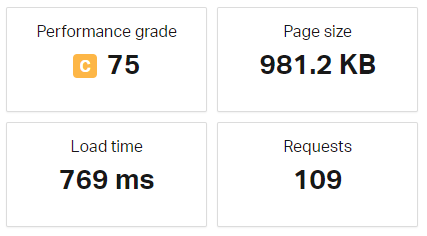If you’re a website owner, it’s incredibly important to minimize your site’s page load speed. This might seem like a minor issue, but it’s actually a pretty big deal.
In this article, we’ll discuss the importance of improving your WordPress site’s page load speed and how you can go about doing so.
Reasons to Focus on WordPress Page Load Speed

You might think that your WordPress page load speed is inconsequential, but you’d be wrong. Terribly wrong.
Here are two of the most important reasons to care about your page load speed.
WordPress Site Speed Helps for SEO Ranking
The purpose of all search engines is to lead viewers to the best possible websites and enhance their user experience. As such, page load speed is an important factor – users don’t like to wait for sites to load.
Google has officially announced that page speed is a factor they take into consideration when ranking websites. Simply put, a faster website is likely to rank higher and get more traffic.
Third-party SEO studies have also found that faster page load speeds are associated with higher rankings in Google:
- Moz’s search ranking factors study found a significant correlation between server response time and Google rankings.
- SearchMetric’s ranking factors study also found links between load times and rankings.
- Neil Patel’s study found a connection between time-to-first-byte (TTFB) and Google rankings.
Bottom Line: If you want your website to be visible and accessible to a larger audience, you need to minimize your page load times.
Retaining Viewers
This point is basically an extension of what we mentioned already. If you want to retain viewers, you need to have a fast website.
In case you weren’t already aware, internet users aren’t the most patient. Consider the following statistics:
- 47% of all internet users expect a page load speeds less than 2 seconds.
- If your website takes over three seconds to load, over 40% of the viewers will likely abandon it altogether.
- eCommerce websites that take long to load don’t receive repeat shoppers.
- A one second delay reduces the average conversions by 7% and page views by 11%.
Bottom Line: If you want to attract a greater viewership (and retain them), you need to focus on improving your page load speed.
How to Test WordPress Page Load Speed
Are you uncertain about your page load speed?
Since you constantly load your own website in your browser, it’s not possible for you to determine how a new viewer would experience the website in a fresh browser. Your computer and browser have cached everything from CSS files to DNS records to make loading your site faster.
To check how your page loads for a new user in different areas, you need to run a page load speed test.
The two most popular platforms you can use to test your page load speed are GTmetrix and Pingdom.
You simply have to enter your website address, select the server location, and click ‘Start Test’. Within seconds, you’ll find out your page load speed in different locations.
But how do you determine if your page load speed is good or bad?
The “Ideal” WordPress Page Load Speed
Faster is always better, but how fast is “good enough”? As referenced above, the majority of internet users are happy if a webpage loads within 2 seconds. So that’s a good benchmark you can use to determine whether your page load speed is good.
2 seconds is the threshold for ecommerce website acceptability. At Google, we aim for under a half second.
– Maile Ohye, Senior Principal Product Manager at Google
How To Improve Your WordPress Page Load Speed
Now that you understand the importance of page load speed, it’s time to figure out how to optimize it. Here are some of the most effective measures you can use.
Upgrade Web Hosting to SSD + Dedicated Resources
Upgrading your web hosting package means that your web server can more quickly execute the PHP code and database calls that are required each time a WordPress webpage page is viewed. We’ve identified two key web hosting features that significantly improve load times:
- Solid State Drives (SSDs) allow your web server to read files and data much faster. SSDs use microchips which is different from traditional mechanical drives in which the data is inscribed on a spinning drive. Upgrading your web hosting to use SSDs can be incredibly beneficial. They can increase the efficiency of boot time, file copying, and file opening. As such, SSD servers are over 7 times faster than mechanical servers.
- Dedicated CPU & RAM Resources. Each time a visitor requests a page from your WordPress website, a lot of activity has to happen behind the scenes. That includes actions by multiple pieces of software: Apache, Linux, PHP, WordPress, MySQL, and more. Every action requires processor (CPU) power and memory (RAM). If you’re on a shared hosting environment, your website will have to wait in line / use the available resources. Upgrading your web hosting account to have dedicated resources (such as VPS hosting) gives your website more processor power and memory, resulting in faster execution and load times.
Install a Server Side Caching Plugin
When a user accesses a website for the first time, the server has to fetch files, execute application code, fetch database values, and assemble the result into an HTML page. WordPress has to execute thousands of lines of PHP code and make multiple MySQL queries just to load one page. Without caching, this process would have to be repeated every time the user refreshes the page.
Caching is one of the most important page speed boosting measures you can incorporate. It’s also one of the easiest to handle.
With caching enabled, the server pre-processes all the queries and saves a static HTML version of the webpage. When a user requests that page, the server simply sends back the already generated static copy of the page. That can easily cut down page load time by around 50%.
There are a number of caching plugins available on WordPress – two of the most reliable and popular are WP Super Cache and W3 Total Cache.
Use a CDN
A Content Delivery Network (CDN) is a geographically distributed set of servers that work in coordination to increase website speed. It can do so through numerous means:
- Your static files are hosted on several servers simultaneously. As such, when someone accesses your website, they receive the information from the closest server.
- They quickly transfer requested assets like HTML, javascript files, videos, media, etc. to the user.
- You can enable full webpage caching to considerably boost page load speed. This saves a static copy of your webpages on the CDN servers, allowing them to instantly serve up the requested page to the user, without your site having to execute code or query a database.
Cloudflare is a very popular CDN on the market, and it’s used by many websites, from small to large.
Check your Plugins and Delete Unnecessary Ones
With every plugin you add, you are decreasing your website’s loading speed slightly.
This occurs for a number of reasons:
- Every plugin is additional code and database queries that have to be processed.
- Some third-party plugins are poorly coded. As such, they can immediately shoot up your page load speed.
You should check all your plugins to make sure they’re not consuming an inordinate amount of resources. And you should get rid of any plugins you don’t really need.
Enable Gzip Compression
Enabling Gzip compression on your web server will compress your CSS, HTML, and JavaScript files before they are sent to users. This can reduce the download time required to transfer your website files from your server to the user’s computer. Host Advice has a great guide to enabling Gzip compression.
Tip: Don’t use Gzip on your images…use Photoshop or another image editing tool to optimize their file size manually.
Optimize Your Images
WordPress has built-in image resizing and compresion, but sometimes there are opportunities to further optimize your image sizes. The goal is to be sure your image file sizes are as small as possible without reducing image quality to an unacceptable level.
One advanced tactic you can use is CSS image sprites. Essentially, this combines multiple images into a single image, then uses CSS to only show the part you want to display. This means that users can download a single image instead of needing to request dozens of individual files from your server.
Use Google PageSpeed Insights
Google PageSpeed Insights is a tool that provides customized information about improvements that your website can benefit from. Enter your URL and run a report, and you’ll get very specific recommended changes, like this:
A few things to keep in mind:
- Google is also dedicated to serving mobile users so they will provide solutions that will benefit the page load speed in website browsers and mobile browsers.
- Keep in mind that you don’t need to implement every recommendation. Some of their recommendations will offer significant improvements, while others may take a long time to implement while they offer only negligible results.
- The recommendations tends to focus on coding changes like minifying CSS, removing blocking Javascript, etc. The tool can’t see things like whether your web hosting uses SSD, so it won’t mention tactics like that.
- Don’t focus too much on getting a perfect score – focus more on your actual page load speed. Even Google doesn’t get a perfect score on their own websites.
Ensure Your Server Supports HTTP2
HTTP2 is a pretty new development in web servers and most people aren’t even aware of it. Most current web servers use the HTTP protocol v1.1. However, you should ensure that your server supports HTTP v2 because it has a number of benefits.
How can HTTP2 increase page load speed?
- It uses a single connection instead of multiple parallel connections.
- Important files are transferred first so the viewer receives the necessary information immediately.
- Compression is used to speed up header transfer.
- Binary data replaces bulky text data transfer.
However, you should know that you need an SSL certificate to use HTTP2. As such, if you don’t have an HTTPS website, you should first buy an SSL certificate. Not only will this increase your page load speed by allowing you to use HTTP2, it will also add security to your website.
Consider AMP
AMP stands for “Accelerated Mobile Pages”. It is one of Google’s open source projects that allows content publishers to offer basic content to mobile visitors at faster speeds. A few popular websites using AMP are Wall Street Journal, Time, Buzzfeed, New York Times, amongst many others.
AMP is a bit more complicated to set up than the other tactics mentioned in this article, so it’s probably only worth doing if you have a significant amount of mobile visitors. There are a few WordPress plugins to help you get started with AMP.
Conclusion
If you follow all of the suggestions in this article, your website should be well on the way to the 2-second benchmark! Keep an eye on your page load speed and keep adjusting to keep your WordPress website loading fast.






